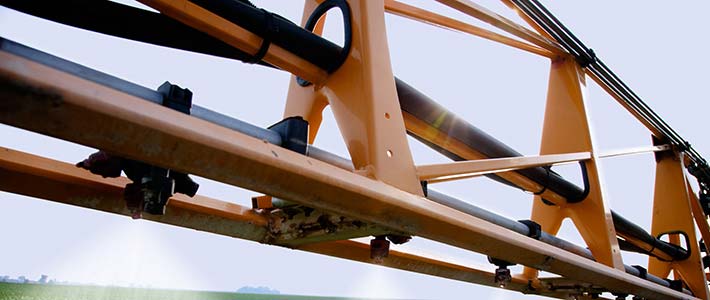Soybeans are emerging and many are in the early seedling stage. The damage from seed damaging insects like seedcorn maggot is waning.
Stand reducing pests like white grub and cutworms can still be active into the early trifoliate stages, but as the soybean grows, UMN Extension literature suggests defoliators and sap feeders will become more important. The bean leaf beetle is one of the defoliators more critical to monitor in the seedling stage and again later in the summer.
The bean leaf beetle is native to North America. The adults can cause damage throughout the growing season, feeding on stems, foliage and pods. The adults are about ¼ inch long, usually tan or yellow in color but red individuals also occur. Like color, markings are highly variable. All bean leaf beetles will have a triangular black mark at the base of the two wing covers of the insect. A few beetles only have this dark triangle but more typically, each wing cover has three more spots and a dark border. When disturbed, the beetle typically falls to the ground, legs folded, “playing possum.”
Bean leaf beetle adults overwinter in the leaf litter near field edges. These overwintering adults may initially feed on forage legumes (clovers, alfalfa, etc.) before moving into earliest emerging soybean fields, feeding on the cotyledons, stems, immature unifoliate leaves, and emerging trifoliolates.
Feeding is focused on the youngest, upper foliage. The feeding by overwintered bean leaf beetles can transmit bean pod mottle virus in areas where both bean leaf beetle and virus occur. Bean pod mottle virus can impact both yield and seed quality, the latter a concern for food grade and seed beans. The overwintering beetles are the generation that most often causes the greatest concern for pest management.
These overwintering adults mate and lay eggs at the base of the soybean plant where the larvae will feed on subsurface root material. The segmented, white bodied, brown headed bean leaf beetle larva has three sets of small legs behind the head. Larvae feed on the soybean roots and nitrogen fixing nodules, seldom injuring roots to the point of reduced soybean yield.
In southern Minnesota, the larvae mature, pupate in the soil and first generation adults emerge in July. This generation feeds on soybeans and as soybeans mature, leave the field to hibernate. A later, second generation is possible in warmer years with early springs.
A heavy adult infestation will cause serious leaf and can damage pods economically impacting yield. Additionally, pathogens have been found to infect injured pods producing molding, shriveled, discolored diseased beans reducing seed quality.
As the result of several cold winters and incidental control of 1st generation adults with sprays for soybean aphid, bean leaf beetle populations have been very low in Minnesota for several years.
Growers should inspect early emerging seedling field edges for beetle adults and defoliation damage. For 1st generation adults, bean pods should also be inspected. Inspect at least 10 plants across the scouting area; examine leaves from the bottom, mid and top of the plant, rating for percent defoliation to assess defoliation of the entire soybean canopy not just the worst leaves. The average percent defoliation can then be used to determine treatment thresholds.
University of Minnesota Extension Entomologist Bob Koch has a visual guide to estimate defoliation loss at this site. At the vegetative stage of growth, treat when beetles are present and percent defoliation reaches 30 percent. At the reproductive (flowering) stage of soybean growth, treat when beetles are present and defoliation. After pods have formed, treat when beetles are present and 10% of the pods are attacked. Scouting should continue after treatment to manage re-colonization if it occurs.
Literature
http://www.extension.umn.edu/agriculture/soybean/pest/bean-leaf-beetle/
https://extension.entm.purdue.edu/fieldcropsipm/insects/bean-leaf-beetle.php
Dr. Bob Koch, University of Minnesota Extension Entomologist, and Bruce Potter, University of Minnesota Integrated Pest Management Specialist, also contributed this report.







